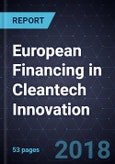Understanding Public Financing Options in Cleantech Innovation
This study provides an analytical overview of public financing instruments available for innovative cleantech start-ups and small and medium enterprises (SMEs) operating in Europe. Many of these instruments operate under the theme of Horizon 2020, the largest European research and innovation programme with a total funding capacity of €80 Billion from 2014-2020.
The most common types of funding provided include loan-based and equity-based financing. Some instruments provide grants and guarantees as well. Some of the common thematic fields for which financing support is being provided include energy efficiency, smart cities, ICT, renewable energy, and healthcare. The European Investment Bank (EIB) and European Investment Fund (EIF) are the two prominent managing bodies of these funding instruments. Other managing bodies include the European Bank for Reconstruction and Development (EBRD), EUREKA, and the European Commission.
While some instruments provide direct funding to SMEs and start-ups, others operate through financial intermediaries. For example, this study analyses portfolio size, average investment size, success rate of applications, accepted technology readiness levels (TRL), consortium requirements, maximum percentage of the project financed, as well as the frequency of project monitoring for all instruments covered in this study.
Financial instruments have been benchmarked in each of these categories mentioned to provide a numerical overview of all instruments. It must be taken note that each instrument has been devised to meet a specific need; this can vary from one instrument to another. The researchers find that in addition to financing, additional support is being provided by many instruments in the form of business coaching and training, ideation, business and advisory services, strategy, marketing and commercialization, IP rights and protection, policy support, financial management, process and quality management, R&D support and cooperation, and business acceleration services. While most instruments target SMEs, some target SMEs and research institutions. This is likely to benefit companies operating in partnership with research institutions.








